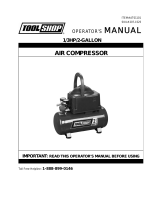
J
A
_To avoid personal injury, always shut off and
unplug the compressor and relieve al! air pressure from
the system before performing any service on the air
compressor.
MAINTENANCE _ ENTRETIEN \ MANTEN_MIENTO 1
MAINTENANCE ] _,_h VERIFICATION DE LA SOUPAPE DE D#CHARGE]
Tirez chaque jour sur la soupape de decharge pour vous
assurer qu'elle fonctionne correctement et 61iminer toutes les
obstructions 6ventuelles.
Regular maintenance will ensure trouble free operation.
Your electric powered air compressor represents high quality
engineering and construction; however, even high quality
machinery requires periodic maintenance. The items listed
below should be inspected on a regular basis.
DRAiNiNG THE TANK ]
_Condensation will accumulate in the
tank. To prevent corrosion of the tank from the inside,
this moisture must be drained at the end of every
workday. Be sure to wear protective eyewear. Relieve
the air pressure in the system and open the petcock
on the bottom of the tank to drain (See B and D) on
pages 11, 12and 13.
NOTE: In cold climates, drain the tank after each use to
reduce problems with freezing of water
condensation.
CHECKING THE RELIEF VALVE ]
Pull the relief valve daily to ensure that it is operating properly
and to clear the valve of any possible obstructions.
TESTING FOR LEAKS i
J
Check that all connections are tight. A small leak in any of
the hoses or pipe connections will substantially reduce the
performance of your air compressor. If you suspect a leak,
spray a smal! amount of soapy water around the area of the
suspected leak with a spray bottle. If bubbles appear, repair or
replace the faulty component. Do not overtighten any
connections.
STORAGE ]
Before storing the compressor for a prolonged period, use
an air b!ow gun to clean all dust and debris from the
compressor. Disconnect the power cord and coil it up. Pull the
pressure relief valve to release all pressure from the tank.
Drain all moisture from the tank. Cover the entire unit to protect
it from moisture and dust.
ENTRETIEN
LIk _Pour 6viter les risques de
blessures, arr6tez et debranchez toujours le compresseur
et lib6rez toute la pression d'air dans le circuit avant
de proc6der a I'entretien.
L'entretien regulier de Fapparei! permettra d'assurer un
fonctionnement sans problemes. Votre compresseur d'air
61ectrique est un appareil de haute qualit6 ; toutefois, m6me les
machines de haute qualit6 necessitent un entretien p6riodique.
Les composants 6numer6s ci-dessous doivent 6tre inspect6s
r6qulierement.
WDANGE DU RESERVOIR
_ll _De la condensation se
forme dans le reservoir. Pour 6viter la formation de
corrosion depuis !'int6rieur du r6servoir, cette
condensation doit 6tre 6vacuee a la fin de chaque
journ6e de travai!. Veillez a porter des lunettes de
protection. Liberez la pression d'air dans le circuit et
ouvrez le robinet de purge en bas du reservoir pour
vidanger (Voir Bet D) aux pages 11, 12 et 13.
REMARQUE : Dans les climats froids, purger le r6servoir
apr6s chaque utilisation afin de r6duire les problemes de gel
d'eau de condensation.
ESSAI D'¢:TANCHEIT_:
Assurez-vous que tousles raccords sont serres. Le
rendement de votre compresseur peut _tre r6duit de maniere
significative en pr6sence d'une petite fuite d'air dans les tuyaux
flexibles, ou les raccords de tuyauterie. Si vous suspectez une
fuite, vaporisez un peu d'eau savonneuse autour de la zone. Si
des bulles apparaissent, r6parez ou remplacez le composant
defectueux. Ne serrez pas trop.
ENTREPOSAGE
Avant d'entreposer le compresseur pour une p6riode
prolong6e, utilisez une soufflette pour nettoyer toute la
poussiere et tous les debris du compresseur. D6branchez le
cordon d'alimentation et enroulez-le. Tirez sur la soupape de
d6charge pour libSrer toute la pression darts le r6servoir.
Evacuez toute I'humidit6 du reservoir. Couvrez tout I'appareil
pour le prot6ger de I'humidit6 et de la poussiere.
MANTENIMiENTO
_Para evitar lesiones personales,
siempre apague y desenchufe e! compresor y alivie toda la
presi6n de a_redel sistema antes de realizar algOn tipo de
servicio en eI compresor de aire.
E! mantenimiento regular asegurara una operaci6n sin
problemas. Su compresor de aire con alimentaci6n ei6ctrica
representa Io meior en ingenieria y construcci6n; sin embargo,
aOn la maquinaria de meior calidad requiere un mantenimiento
peri6dico. Los elementos enumerados a continuaciSn deben
inspeccionarse de manera regular.
DESAGUE DEL TANQUE
_La condensaci6n se
._j_ cumular_ en el tanque. Para evitar la corrosi6n del
tanque desde el interior, esta humedad debe ser
drenada al final de cada dia de trabajo. AsegOrese de
utilizar protecci6n ocular. Alivie la presiOn de aire en
el sistema y abra la Ilave de descompresi6n que se
encuentra en e! fondo del tanque para drenar (Vea B
y D) en las p_ginas 11, 12 y 13.
NOTA: En climas frios, drene e! tanque despues de cada
uso a fin de reducir !os problemas por el congelamiento del
agua de condensaci6n.
REViSiON DE LA V.&LVULA DE ALIVlO
Tire de la valvula de alivio todos los dias para asegurarse
de que este operando correctamente y para eliminar cualquier
obstrucci6n posible de la misma.
DETECClON DE FUGAS
Compruebe que todas las conexiones esten ajustadas.
Una pequeda fuga en cualquiera de las mangueras, o tuberia
reducira de manera substancial e! rendimiento de su
compresor de mire. Si sospecha la existencia de una fuga,
rocie una pequeda cantidad de agua iabonosa alrededor de la
zona con una botella rociadora. Si aparecen burbuias, selle y
aiuste nuevamente la conexi6n. No aiuste demasiado.
ALMACENAMIENTO 1
Antes de almacenar e! compresor durante periodos
pro!ongados, use un soplete de aire para limpiar todo e! polvo
y suciedad de! compresor. Desconecte el cordon el6ctrico,
enrollandolo. Tire de la v_lvula de alivio de la presi6n para
liberar toda la presi6n del tanque. Elimine toda la humedad del
tanque. Cubra toda la unidad para protegerla de la humedad y
del polvo.
14 200-2430














